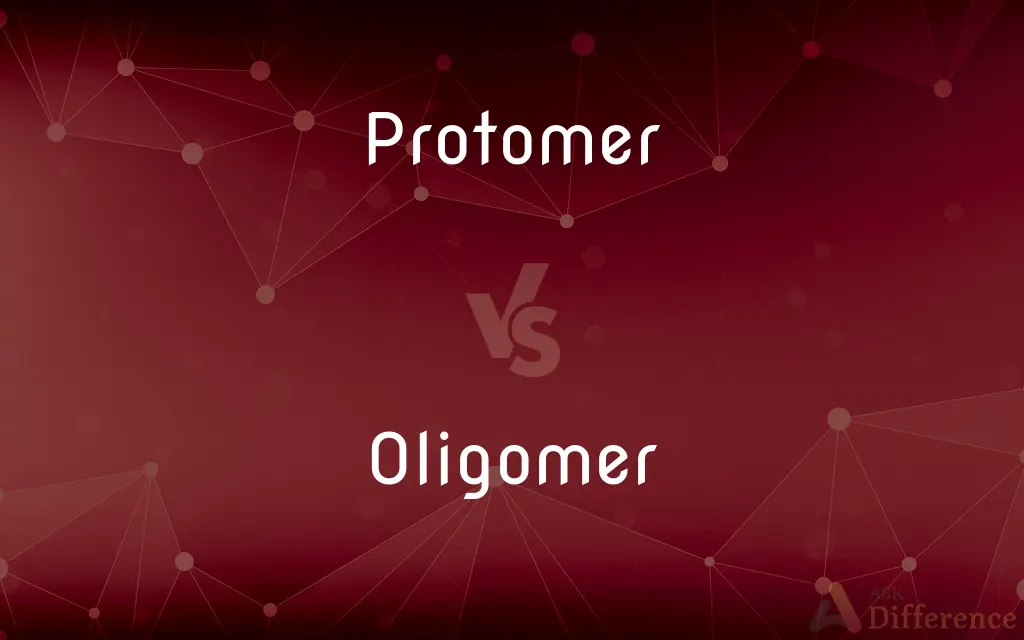Protomer vs. Oligomer — What's the Difference?
By Tayyaba Rehman & Fiza Rafique — Updated on March 15, 2024
A protomer is a specific conformational form of a molecule in equilibrium with other forms, whereas an oligomer is a molecule made of a few repeating units.

Difference Between Protomer and Oligomer
Table of Contents
ADVERTISEMENT
Key Differences
Protomers refer to different conformational or structural forms of a molecule, often in a chemical equilibrium, where each form has a specific arrangement of atoms and bonds but shares the same molecular formula. Oligomers, on the other hand, are relatively small polymers, consisting of a few monomer units (typically between two and twenty). They can be formed through various polymerization processes and can have distinct physical and chemical properties depending on the nature of their monomeric units and the structure of the oligomer.
Protomers is commonly encountered in the study of tautomers, where protomers interconvert through the relocation of a proton and a change in the location of a double bond. For example, in keto-enol tautomerism, the keto and enol forms are protomers of each other. Oligomers play a crucial role in materials science, biochemistry, and molecular biology. For instance, dimers, trimers, and tetramers are types of oligomers commonly found in various biological and synthetic compounds.
While protomerism focuses on the dynamic equilibrium between different structural forms of the same molecule, oligomerization concerns the assembly of monomeric units into larger structures. Protomerism is a concept deeply rooted in the study of molecular structure and reactivity, particularly in the context of organic chemistry and enzymology. Oligomerization has broader applications, including the design and synthesis of new materials, understanding the structure-function relationships in biological macromolecules, and developing novel therapeutic agents.
The distinction between protomers and oligomers is fundamental to various scientific disciplines, underscoring the diversity and complexity of molecular structures and their transformations. Understanding these concepts is crucial for advancing research in chemistry, materials science, and biology, where the manipulation of molecular structures and assemblies can lead to significant innovations.
Comparison Chart
Definition
A specific structural form of a molecule in equilibrium with other forms.
A molecule composed of a few repeating monomer units.
ADVERTISEMENT
Key Concept
Conformational or structural variations of the same molecule.
Assembly of monomer units into larger structures.
Examples
Keto and enol forms in keto-enol tautomerism.
Dimers, trimers, and tetramers in polymers and biological molecules.
Relevance
Important in understanding molecular reactivity and structure.
Crucial in materials science, biochemistry, and polymer chemistry.
Applications
Study of molecular dynamics, enzymology, and organic reactions.
Design of new materials, understanding biological macromolecules, drug development.
Compare with Definitions
Protomer
A specific structural form of a molecule that is part of an equilibrium with other forms.
In acetoacetic acid, the keto form and the enol form are protomers.
Oligomer
A molecule formed from a few monomer units, smaller than a polymer.
A peptide with four amino acids is an oligomer known as a tetrapeptide.
Protomer
Molecular entities that differ in the position of protons and electrons but maintain the same formula.
Protomers of a DNA base can lead to mutations during replication.
Oligomer
The initial stage in the polymerization process, consisting of dimers, trimers, etc.
During polymerization, the formation of oligomers precedes long-chain polymers.
Protomer
The concept used to describe dynamic changes in molecular structure.
Studying protomer equilibrium can help understand enzyme-substrate specificity.
Oligomer
A compound in biochemistry representing a small assembly of monomeric units.
The alpha-hemolysin heptamer, an oligomer forming a pore in cellular membranes.
Protomer
A term used in the context of chemical reactivity and molecular dynamics.
Protomerization plays a key role in the acid-base behavior of certain compounds.
Oligomer
The classification of molecules based on the number of repeating units.
Oligonucleotides are oligomers used in genetic research and diagnostics.
Protomer
Different conformational or tautomeric forms interconverting through proton shifts.
The lactam and lactim forms of a cyclic amide are protomers.
Oligomer
Materials science term for small polymers with specific properties.
Oligomeric siloxanes are used to create hydrophobic coatings on glass.
Protomer
In structural biology, a protomer is the structural unit of an oligomeric protein. It is the smallest unit composed of at least two different protein chains that form a larger hetero-oligomer by association of two or more copies of this unit.
Oligomer
In chemistry and biochemistry, an oligomer ( (listen)) is a molecule that consists of a few similar or identical repeating units which could be derived, actually or conceptually, from copies of a smaller molecule, its monomer. The name is composed from Greek elements oligo-, "a few" and -mer, "parts".
Protomer
Each of a number of tautomeric molecules which differ from each other only in the position of a proton; a prototropic tautomer.
Oligomer
A polymer whose molecules consist of relatively few repeating units.
Protomer
Each of the protein subunits of which an oligomeric protein is built up.
Oligomer
A polymer consisting of at least 2 and as many as 100 monomers.
Protomer
(chemistry) Any prototropic tautomer.
Oligomer
(chemistry) A compound intermediate between a monomer and a polymer, normally having a specified number of units between about five and a hundred.
Protomer
(biochemistry) Any of the subunits that constitute an oligomeric protein.
Oligomer
A molecule composed of a small number of linked monomer units; a short polymer; - compounds called oligomers have less than one hundred monomer units and usually less than thirty. Oligomers of increasing length are called dimer, trimer, tetramer, pentamer, hexamer, heptamer, octamer, nonamer, decamer, etc. In colloquial laboratory jargon, they may also be referred to as nine-mer, ten-mer, eleven-mer, twelve-mer, etc., especially for oligomers of greater than eight units.
Common Curiosities
Can protomers exist within oligomers?
Yes, if the monomeric units within an oligomer can exist in different tautomeric forms, then those forms can be considered protomers.
How does an oligomer differ from a polymer?
An oligomer is composed of a few monomer units, while a polymer consists of many monomers, often hundreds or thousands, forming larger and more complex structures.
Why are oligomers important in biology?
Oligomers are crucial in biology because they form the structural basis for many biological macromolecules and play key roles in biological processes and structures.
What role do oligomers play in materials science?
In materials science, oligomers are used as precursors for polymers and as components in materials with unique properties, like elasticity, strength, or optical characteristics.
What is a protomer in chemistry?
A protomer is one of several structural forms of a molecule that are in dynamic equilibrium with each other, differing in the position of protons and electrons.
Can the concept of protomerism be applied to inorganic molecules?
Yes, protomerism can also apply to inorganic molecules where there is an equilibrium between different structural forms involving proton or electron shifts.
How are protomers identified?
Protomers are often identified through spectroscopic techniques that can detect slight differences in molecular structure, such as NMR or IR spectroscopy.
Are all oligomers synthetic?
No, oligomers can be both synthetic and natural. For example, oligosaccharides are natural oligomers found in many biological systems.
What determines the equilibrium between different protomers?
The equilibrium between protomers is influenced by factors such as the solvent, temperature, pH, and the presence of catalytic species.
How are oligomers used in drug development?
Oligomers, like oligonucleotides, are used in drug development for therapies targeting genetic disorders, serving as agents for gene silencing or modulation.
Share Your Discovery

Previous Comparison
Inaccurate vs. Accurate
Next Comparison
Wool vs. SherpaAuthor Spotlight
Written by
Tayyaba RehmanTayyaba Rehman is a distinguished writer, currently serving as a primary contributor to askdifference.com. As a researcher in semantics and etymology, Tayyaba's passion for the complexity of languages and their distinctions has found a perfect home on the platform. Tayyaba delves into the intricacies of language, distinguishing between commonly confused words and phrases, thereby providing clarity for readers worldwide.
Co-written by
Fiza RafiqueFiza Rafique is a skilled content writer at AskDifference.com, where she meticulously refines and enhances written pieces. Drawing from her vast editorial expertise, Fiza ensures clarity, accuracy, and precision in every article. Passionate about language, she continually seeks to elevate the quality of content for readers worldwide.
















































